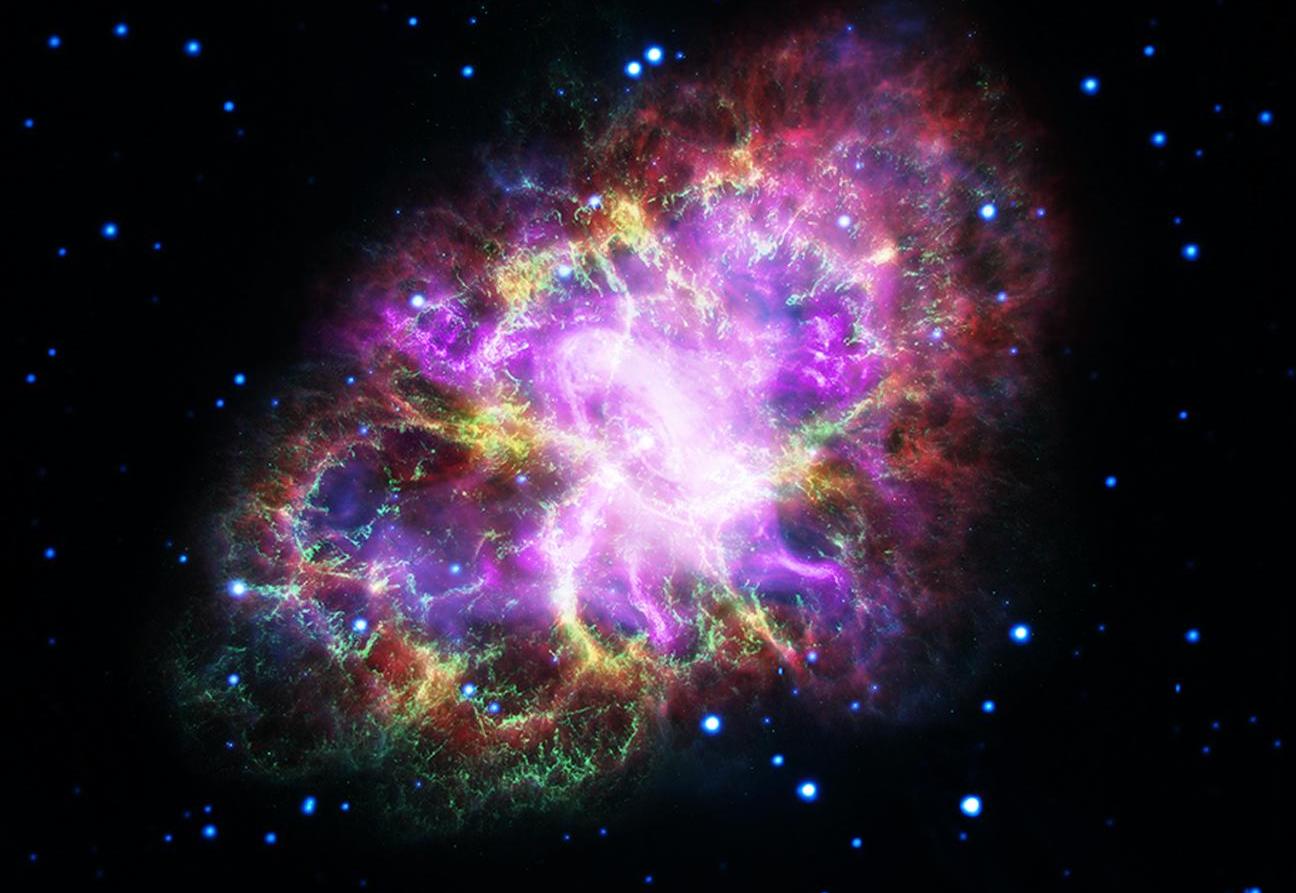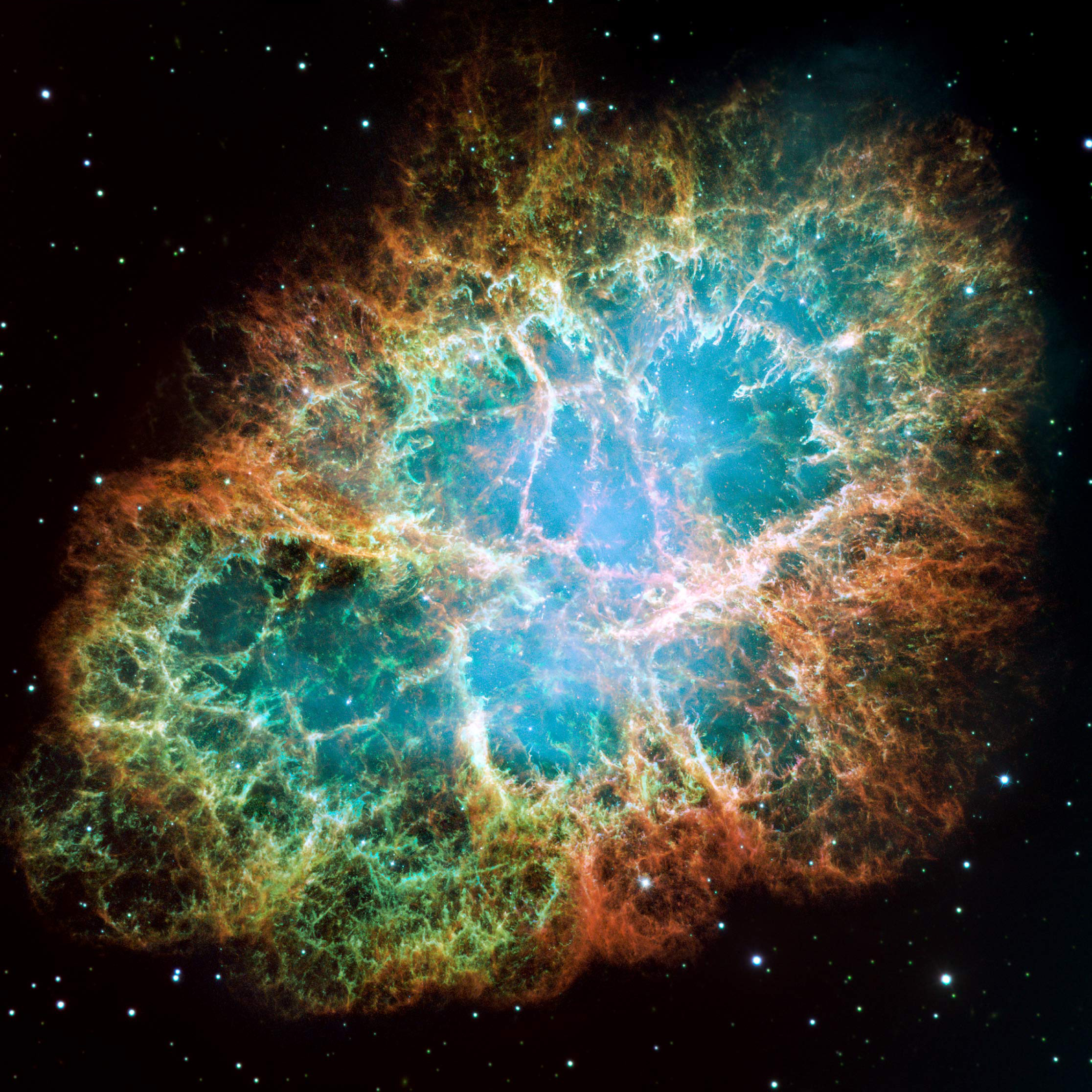Mystery explosion 1,000 years ago may be a rare, third type of supernova
The blast lit up the sky for 23 days and nights in A.D. 1054.

On July 4, 1054 — about 700 years before the United States popped its first celebratory firework — a mysterious light exploded in the sky.
The blast was visible around the world, lingering in the daytime sky for nearly a month, and visible at night for nearly two years, according to NASA. At the time, Chinese astronomers labeled the mysterious blaze a "guest star" — a temporary heavenly object that seemingly appeared from nothing, then vanished to nothing. But modern space telescopes like NASA's Hubble reveal that Earth's strange "guest" is here to stay (albeit 6,500 light-years away).
What's left of that ancient blaze is known today as the Crab Nebula — a vast and rapidly-expanding balloon of irradiated gas with a powerful neutron star pulsing at its center. Nebulas like these are the smoldering remains of once-mighty stars that lost most of their mass in tremendous, end-of-life supernova explosions.
Many scientists now suspect that the mysterious light reported in 1054 was the Crab Nebula's progenitor star going boom (an event they now call SN 1054). But why a previously invisible star should explode so brightly and decorate Earth's sky for so long is a question that still boggles astronomers to this day.
Now, careful study of a second supernova — one that lit up the cosmos in March 2018 — could finally answer that 1,000-year-old riddle.
Related: Hubble just took a gorgeous new image of the southern Crab nebula's wonky gas bubbles
In a study published June 28 in the journal Nature Astronomy, researchers studied the gassy remains of that more recent explosion (named SN 2018zd) and matched it up with archival images showing what its progenitor star looked like before it blew its top. After a thorough before-and-after comparison, the team found that this dying star showed all the hallmarks of a rare, theoretical type of supernova explosion that has never been detected in the cosmos before — an electron-capture supernova.
Sign up for the Live Science daily newsletter now
Get the world’s most fascinating discoveries delivered straight to your inbox.
With new data in hand, it's looking increasingly likely that the Crab Nebula's spectacular birth was also triggered by this same sort of elusive explosion, the researchers said.
"The Crab supernova has been suggested as an electron-capture supernova, but since it happened a thousand years ago, there is not much data on the progenitor star and the explosion itself," lead study author Daichi Hiramatsu, a graduate student at the University of California, Santa Barbara (UCSB), told Live Science in an email. "This is where our research fits in — providing modern observations of a progenitor star and supernova explosion, and bridging our understanding of electron-capture supernovae from the explosion to the remnant."

The third nova
When a star explodes, it typically goes out in one of two ways: A thermonuclear supernova, or an iron core-collapse supernova.
A thermonuclear supernova occurs when a white dwarf (the withered core of a star up to eight times the mass of the sun) sucks away too much gas from a companion star. The white dwarf core heats up, fusing elements together in ever-hotter reactions until, finally, the star explodes in a brilliant blast. Meanwhile, a core-collapse nova happens when an even larger star (about 10 or more times the sun's mass) runs out of nuclear fuel, causing its iron core to collapse into an ultra-dense black hole or neutron star.
Electron-capture supernovas fit between these two categories, springing from stars of between eight and 10 solar masses — not too heavy, not too light. Since the 1980s, astronomers have calculated that stars in this transitional mass range could be victim to a strange kind of death, where an overwhelming gravitational force crushes the star's core, causing electrons in the core to smash into their atomic nuclei, triggering a core collapse, the researchers wrote.
Related: This is what a supernova sounds like, according to NASA
A star that dies in this manner should leave a few key signatures, according to the new paper. For one, the progenitor star should start out fairly massive, but lose much of its mass before the explosion begins, filling the space around it with an aura of ejected gas. When the star's core finally does blow, it will produce a relatively weak, slow-moving explosion that interacts with the nearby gas, lighting it up more brightly than would be expected.
Scientists have never found a star that perfectly matches these criteria — until March 2018, when a distant star 31 million light-years from Earth flickered out of existence. In their new study, the researchers analyzed the star using data from both the Hubble and Spitzer Space Telescopes to match the supernova remnant (SN 2018zd) with the progenitor star that created it. They found that the star and explosion matched all of the criteria for the fabled electron-capture supernova.
"We started by asking 'what's this weirdo [supernova]?'" Hiramatsu said in a statement. "Then we examined every aspect of SN 2018zd and realized that all of them can be explained in the electron-capture scenario."
This research not only helps validate an astrophysical theory dating back 40 years, but also gives scientists a new way to look at the remnants of dead stars, Hiramatsu added.
The crab's secret
Having watched an electron-capture supernova unfold "live" before their telescopes, the study authors quickly applied what they saw to the ancient Crab Nebula explosion, which previous studies had suggested to be a possible electron-capture supernova as well. The team noticed many similarities between the two remnants, including low-velocity explosions (indicating that, like SN 2018zd, the Crab Nebula progenitor star lost a lot of mass before it blew) and a strikingly similar chemical composition in the leftover gas, which allowed them to estimate the Crab Nebula progenitor star's size.
According to study co-author Andy Howell, an astronomer at Las Cumbres Observatory in California and adjunct faculty at UCSB, these similarities increase the likelihood that the Crab Nebula was created by an electron-capture supernova 1,000 years ago.
That explanation could also solve the mystery of the ancient explosion's brighter-than-average luminosity as it lingered over Earth. Perhaps the Crab Nebula progenitor star lost a lot of mass before it exploded, just like SN 2018zd did. That would make the resulting supernova appear much brighter than it should have when gas from the explosion collided with the gas surrounding the star, Howell told Live Science.
"Of the six indicators for being an electron-capture supernova, SN 1054 has the right energy, chemical composition, and [fusion of elements]," Howell said, adding that it may have the right amount of mass loss and luminosity, too.
But because we'll never know exactly what the Crab Nebula's progenitor star looked like, or how spectacular its final explosion truly was, pinning a definitive explanation to it could be tricky. At least by scouring the remnants of "weirdo" explosions like SN 2018zd, astronomers are narrowing down the possibilities.
Originally published on Live Science.

Brandon is the space/physics editor at Live Science. His writing has appeared in The Washington Post, Reader's Digest, CBS.com, the Richard Dawkins Foundation website and other outlets. He holds a bachelor's degree in creative writing from the University of Arizona, with minors in journalism and media arts. He enjoys writing most about space, geoscience and the mysteries of the universe.









